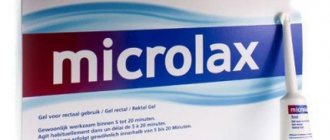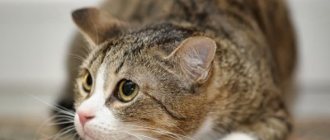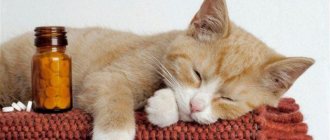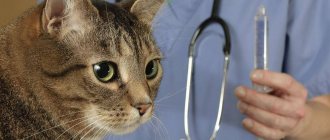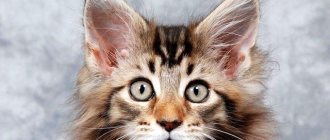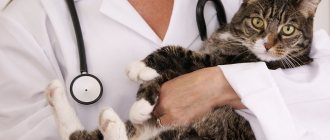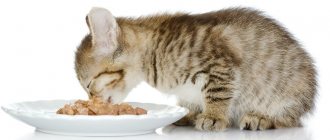The main task of an enema is to soften stool and stimulate bowel movements. The event is also carried out for therapeutic purposes, but this is done exclusively in a veterinary hospital by specialized personnel. In this article we will look at how to give a cat an enema at home as comfortably and painlessly as possible for your pet. The medicinal solutions and pharmaceuticals used, contraindications and indications for the procedure will be described.
The cat is unwell
Signs and main causes of constipation
Constipation is manifested by the following symptoms:
- no stool for more than 3 days;
- there is little stool and it is very dry;
- the cat sits on the tray for a long time, pushing, but to no avail;
- visits to the toilet are painful for the animal;
- flatulence;
- anxiety;
- the anus is swollen.
The causes of constipation are various:
- Most often, constipation is caused by improper nutrition (excess protein, lack of fiber, in kittens - switching to a different diet), stress, or the formation of a hairball, because the cat constantly licks itself. A newborn kitten cannot poop on its own. The cat licks his tummy, anal area and provokes the process of defecation. If a mother does not take care of her newborn children, they will have problems with bowel movements.
- Less common, but more dangerous causes are internal diseases, tumors and hernias in the intestine, deformation of the colon or rectum, and previous injuries (fractures).
- The most serious case when a cat does not pass feces is a volvulus or a foreign body entering the intestines.
An enema for a cat is an acceptable method of treating constipation only if it is caused by reasons related to improperly selected food or the formation of a hairball. If there are internal diseases or intestinal blockage, an enema is deadly. Therefore, a doctor should make a diagnosis and recommend treatment after examination.
Causes of defecation disorders
Very often, various diseases become the causes of constipation in pets. These include diseases of the gastrointestinal tract, kidneys or liver, as well as problems of a neurological and psychological nature.
Constipation must be dealt with immediately, as it can have very disastrous consequences. At this time, the cat may experience heaviness and pain, and it may even lead to intoxication of the entire body, since with constipation, toxins are not eliminated, but accumulate in the animal’s body.
If we look at the statistics, among furry pets cats are more likely to suffer from constipation than cats. In addition, adults are more likely to suffer from problems with bowel movements than young ones.
However, it is worth noting that the most common are irregular problems with bowel movements. If your pet does not have serious illnesses, but is constipated, then the reason may be hidden in the following:
- violation of diet;
- foreign object;
- accumulations of hair in the gastrointestinal tract.
Your cat may need an enema if you begin to notice the following symptoms:
- lethargy;
- lack of appetite or thirst;
- swollen and tight belly;
- no trips to the toilet;
- attempts to defecate without success.
You should pay attention to the fact that cats go to the toilet twice a day. If your pet doesn't go to the toilet at least once a day, it's worth considering.
Contraindications
Enema - as a means of combating constipation is contraindicated in the following cases:
- tumors in the intestines;
- inflammatory process in the gastrointestinal tract;
- volvulus, acute obstruction;
- foreign body in the digestive tract (usually bone);
- pregnancy.
An enema is contraindicated for a cat if feces are excreted in small quantities and are black in color. This is a sign of internal bleeding in the upper digestive tract.
Tips for the owner: how to prevent constipation in a cat
In order not to have to face such a problem as giving an enema to your pet, it is better to avoid such situations at all.
A number of preventive measures will help here:
you can avoid clogging the digestive tract with hairballs if you regularly brush your pet’s fur coat;- your pet's diet should contain only high-quality food enriched with fiber;
- if the cat eats natural products, then the menu includes pureed soups with pumpkin, seasoned with a small amount of vegetable oil, and low-fat fermented milk products (cottage cheese, kefir);
- Vitamin-mineral complexes are used as an addition to the diet, but they are selected together with a veterinarian;
- There should be clean water in the bowl as a means of liquefying the stool.
Outdoor games will help your pet avoid chronic constipation. If a pet does not have the opportunity to run outside, taking care of its physical fitness falls entirely on the owner.
In order for the cat to be active and not lie most of the time in his favorite place, special exercise equipment is installed in the house and toys for animals are purchased.
What is needed to perform an enema?
It is difficult for one person to give an enema to a cat at home. Need an assistant. Not a single cat will voluntarily agree to such a procedure.
To carry out you will need:
- A bulb (syringe), preferably with a rubber tip. The plastic nozzle can seriously injure your cat's anus if he resists, which he will. The volume of the pear depends on age. A 300 ml syringe is suitable for a large adult cat, and 150-200 ml for a kitten.
- The bulb can be replaced by a drip hose and a syringe. The hose has a small diameter and is much easier to insert into the cat's anus. The liquid is supplied into the tube with a large syringe without a needle.
- If you need to give a kitten an enema, you can use a pipette.
- Solution for administration (prepared independently or from a pharmacy).
- Lubrication. Vaseline, vegetable oil or baby cream are used as a lubricant.
- Rubber gloves, basin.
It's easier with an assistant
If you have a helper, trust him to hold the kitten. And carry out all the procedures yourself. This will free up your hands and make it more convenient.
How to properly give an enema to a small kitten.
How to properly give an enema to a small kitten.
How to properly give an enema to a small kitten.
How to properly give an enema to a small kitten.
Enema technique
The cleaning procedure is carried out according to the following scheme:
- The pear is filled with the prepared solution. To do this, you need to squeeze it, lower the tip of the syringe into the solution and gradually release the pressure on the walls. For one procedure you need to take 50-100 ml of solution.
- It is recommended that the assistant place the cat on one arm and hold the paws with the other. If the pet is flexible, then it is more convenient for the owner to place the pet on his left hand. You may have to give the cat a sedative. It's difficult to cope without him.
- Lubricate the tip of the bulb with lubricant and release any air from the syringe.
- Slowly and carefully insert the tip into the anus. The direction is parallel to the spine. It is advisable to first make marks on the nozzle - 1 and 2 cm. For adult cats, the tip is inserted to a depth of 2 cm, for kittens - 1 cm. If the tip does not fit, you cannot press. You need to stop and introduce as much liquid as possible. For a 1-2 month old kitten, it is enough to administer 2-3 pipettes of solution. Abdominal massage will speed up bowel movements.
- After introducing the liquid, the tip of the syringe is carefully removed. You need to press the cat's tail to the anus and hold it with your finger.
To avoid damaging the colon, the solution is administered very slowly. Rapid application of the solution will cause discomfort in the pet and will not soften the stool.
You can allow your pet to go to the toilet directly into the basin.
If blood is found in the stool after an enema, urgent consultation with a veterinarian is required. Blood in feces is a sign of internal disease.
Algorithm of actions
Animals react to any violent actions with resistance. Therefore, before the procedure, the cat will have to be securely secured using straps, a wide ribbon of soft cloth or a towel.
After this, the main steps begin:
- having expelled excess air from the syringe, fill it with solution;
- the tip is lubricated with cream or Vaseline;
insert the pear in a helical manner into the anus parallel to the spine, moving as carefully as possible;- by gradually pressing on the rubber container, they try to pour as much liquid into the intestine as possible;
If the solution does not flow, the manipulation should be stopped so as not to injure the animal. After removing the syringe, the entrance to the anus is covered with the tail, pressing it tightly to the cat’s butt.
The forced hold will take at least 10 minutes. This is inconvenient for both – the cat and the owner. But during this time, the stool will soften and bowel movements will begin. This is where you will need a spacious basin in which to place the pet.
Enema solutions
An enema for a cat with constipation is done with the following solutions:
- Salt based. Dissolve 1 teaspoon of sea salt in 250 ml of water and heat until completely dissolved.
- A solution with baby soap, not very concentrated. The product works effectively, but cannot be used often - it has an irritating effect on the rectum.
- Tap water. Plain water can soften stool and promote its passage.
- Vaseline oil. Use in pure form or add a few drops to water. The oil coats the stool and lubricates the intestinal walls, making it easier for feces to pass through the digestive tract. 5-10 ml of oil is enough for an adult cat and 1 ml if you need to give an enema to a kitten.
- Chamomile decoction. The infusion is made at the rate of a tablespoon of dry chamomile per 200-300 ml of boiling water. The liquid is allowed to brew for 15 minutes, then filtered, cooled to a comfortable temperature and injected using a pear.
A prerequisite is that any solution for rectal administration should not be hot or very cold. The optimal temperature is 25-30 degrees.
It is recommended to resort to traditional methods of treatment if there are no medications in the house, such as microenemas, and there is no opportunity to buy them.
Preventing constipation
Further actions of the owner after the enema should be preventive measures to prevent the re-development of constipation.
- Walking with the cat, increasing his physical activity.
- Drink plenty of fluids; the veterinarian may prescribe drips with saline solution (plenty of liquid softens the stool).
- Introduction of fresh vegetables into the diet.
- Exclusion of dry food.
Preventing constipation
Pharmacy enemas
Using a syringe, tube and syringe is a complex process to perform. It is also important not to overfill the liquid. Without experience and knowledge, this is not easy to do. Therefore, it is better to start with pharmaceutical products. You can do enemas with solutions of lactulose-based medications, for example, Duphalac. Suitable for cats: Microlax and Proctum.
The most popular option is Microlax microenema. For an adult cat, it is enough to inject half the tube. To do this, remove the cap and lightly push the liquid towards the tip of the applicator to lubricate the tip. Then the applicator is smoothly inserted into the anus about 1.5 cm. You need to press hard on the tube, as it is quite hard. The microenema takes effect within 5-10 minutes. If there is no result, then the second half of the product is administered after 3 hours.
The Microlax tip is too large for a kitten, so the suspension is administered to the baby using an insulin syringe (1 ml). Half a syringe is enough.
What do the professionals advise?
The best time to perform a colon cleansing procedure is in the morning, when there is still a lot of time before breakfast.
The most convenient way to fix a cat is with a wide towel, when one end of it is wrapped around the animal’s body and tucked under the feet of the person administering the enema, the other end is wrapped in the same way. Thus, the fluffy begins to resemble a securely packaged package.
Cat in a towel ready for enema
This technique will not allow him to escape in the midst of the procedure and scratch the owner. To ensure the animal's calm before manipulation, you can give it a sedative medication.
Very good advice from experts is to use the help of an assistant, because it is not so convenient for one person to hold the animal and at the same time slowly administer the enema.
After completing the enema, you should thoroughly wash the animal, put its fur in order and provide complete rest so that it can quickly recover from stress.
When the need arises
The need for such manipulation as an enema for a cat may appear in the following situations:
- Incorrect, monotonous diet containing too little fiber and other coarse dietary fibers. Because of this, food stagnates, is poorly digested, and the intestines become atonic, which further aggravates the problem.
- Sudden change in diet. This often happens when the owner changes: the animal cannot quickly get used to the new food, and it experiences either frustration or constipation.
- Insufficient water in cats that eat mostly dry food can not only cause constipation, but also cause intestinal obstruction.
- A chronic form of constipation, which can be caused by the cat's advanced age, obesity, or a sedentary lifestyle.
- Consequences of diseases or surgical interventions.
- Poisoning of various types.
- Inflammatory bowel diseases that prevent independent normal bowel movements.
Before resorting to using an enema, you need to find out whether your pet can do it. And such information can only be given by a veterinarian after conducting a full examination and taking a number of tests.
What to do at home: the main tasks of the owner
The kitten is constipated; every owner needs to know what to do at home, as well as how to prevent the problem. You should be prepared for the fact that the rehabilitation process will require strength and patience on the part of the owners, since animals react sharply to medications and other treatments.
Drug treatments for constipation in kittens
Diarrhea in a kitten: what to do and how to treat it at home
Among the medications, kittens that have reached the age of one month can use Duphalac, Festal, Espumisan, Lactusan and Lizalak. The dose of these drugs is prescribed depending on the weight of the pet. Take 0.5 ml per 1 kg of animal. Give the kitten the product 2 times a day. It is important to prescribe a special diet and monitor the pet’s condition. If constipation does not stop within 24 hours, give a second dose.
Note! Duphalac has a sweet taste and a strong smell, so pets refuse to take it in its usual form. In order not to torment the animal, it is recommended to mix the medicine into food (porridge, pate, soup). If the kitten does not eat food, it is necessary to pour the medicine into the oral cavity using a syringe.
A popular treatment for four-legged animals is espumizan. The product effectively removes gases, eliminates bloating and relieves constipation. Often used to treat poisoning.
Prelax is considered an equally effective remedy. This drug contains lactose, which has a positive effect on the fight against constipation. The syrup has no aroma or cloying taste, so kittens consume it without problems. It can also be mixed into dry or regular food.
Sodium picosulfute helps well, but its use is prescribed by a veterinarian, since the dosage and frequency of use are important.
Intestinal obstruction is eliminated by magnesium sulfate. Before use, you must dilute half the packet in water. Since the product has a bitter taste, kittens will not take it calmly. Therefore, it is recommended to draw the product into a syringe and pour it into the oral cavity. The drug quickly relieves pain, and after 6-9 hours it eliminates constipation.
For the treatment and prevention of constipation, experts recommend the use of bifidumbacterins. They help the intestinal microflora work better.
Important! Despite the fact that medications have a mild effect and do not pose any danger, you should consult your doctor. Some laxatives for kittens 2 months and older may differ in the method of administration.
Medicines are the best way to solve the problem
How to do a belly massage
To understand how to massage a kitten's tummy, you need to lay the animal on its back and start stroking from head to belly. Hand movements should be smooth and soft. In the intestinal area, you can make 5-10 circular rotations clockwise. Ideally, the duration of a cat massage for constipation should be 4-10 minutes. 2 times a day.
For your information! For pets under 1 month of age, tummy massage should be a daily procedure, regardless of whether there is constipation or not.
What to feed a kitten with constipation
In addition to medications, proper nutrition should be involved in the treatment of constipation. It is necessary to include the optimal amount of fats, fiber and proteins in your daily diet.
Many owners prefer to feed their pets with ready-made food, relying on its correct composition. In this case, it is worth paying attention to premium food, since many conventional manufacturers make food for cats from waste. There should always be clean water next to the food, as the correct water balance has a positive effect on digestion.
If your pet eats natural food, you should not give it food from the common table. Large amounts of salt, sugar and spices can disrupt the functioning of the intestines.
You can give your kitten low-fat cottage cheese, milk, cream, soft porridge, light meat broth. Meats such as veal, chicken and lean fish are acceptable. Avoid spicy and salty foods, fatty fish and meat.
How to give a kitten an enema
An enema is an emergency measure that is used in advanced cases. To perform the procedure, you need to take a 10 mg syringe without a needle. It is best if during the process the person has an assistant who will hold the cat in a standing position and ensure its immobility. An enema is a mentally difficult procedure for both the pet and the owner, so you need to prepare yourself for the process in advance.
Note! It is best to do an enema in the morning, when the baby has just woken up and is as relaxed as possible.
To simplify the procedure and make the manipulation painless, you need to lubricate the tip of the syringe with oil or Vaseline. When injecting, it is important to ensure that the tip of the syringe is at the correct depth so that the liquid does not flow back out.
The liquid is introduced slowly; at the same time, you should feel the cat’s stomach; when it is full, the tip is smoothly removed back. Then you need to gently massage and palpate the kitten's belly to detect stagnation of feces. When the area is found, you should try to crush and separate them using smooth movements.
Important! All actions are carried out gently and smoothly so as not to cause pain to the kitten or damage internal organs.
If the procedure was successful, the stagnant remains of feces should come out along with the water. Before the enema, it is recommended to place the animal in any container that is easy to clean in case of contamination. The water in the syringe must be clean, at a temperature of at least 22 °C.
Continue until the liquid becomes clear. As a result, 2-3 procedures may be needed to completely clear the contents of the rectum.
Along with an enema, experienced breeders recommend using soap from which a small candle is made. This remedy is carefully injected into the kitten's rectum. Soap components irritate the mucous membrane, thereby contracting the intestines and relaxing it. As a result, emptying should occur.
Note! Do not use aggressive detergents, such as antibacterial soap. Good products for children's skin. Otherwise, an allergic reaction and irritation may occur.
Condensed milk
A specific and popular remedy for obstruction is condensed milk. The pet needs to be given a little of the regular product or diluted with raw water. This mixture normalizes the process of defecation and also softens stool. However, you should not use this method often, since condensed milk puts a serious burden on the liver and also has a high calorie content.
All cats love milk
Using Vaseline Oil
Vaseline oil is applied orally. There is 1.5 ml of product per 1 kg of animal. Used 1 to 3 times per day. The product helps soften stool and normalize its waste. The oil has a positive effect on the functioning of the intestines, is not absorbed into the blood and facilitates the process of bowel movements.
Important! Castor oil should not be confused with Vaseline oil. The latter is not recommended for use on kittens, as the product causes pain and also affects the functioning of the liver.
It is recommended to give Vaseline oil to kittens in a sitting position, so the product penetrates the stomach faster and eliminates the risk of the animal suffocating.
In what cases is it necessary to give an enema?
Cleansing the intestinal tract is not only done for constipation. An enema is simply necessary for various food poisonings, when you need to quickly get rid of harmful substances. There is also a digestive enema, which is given when it is impossible for the kitten to feed naturally, for example, if it does not feel well. Such an enema will support his vital functions. If you need to lower the temperature, then use thermoregulating enemas. In addition, there are also relaxing, diagnostic and medicinal enemas.
Veterinarian recommendations
As recommendations, here are the veterinarian's notes:
- The best time to perform an enema is early in the morning.
- Talk to your pet, stroke him. Your calmness and calming tone will prepare the cat, and he will be more willing to trust you.
- Massaging the cat's abdomen under the pelvis will help loosen the fecal impaction. It is in this area that you can feel hard stool.
- Pay attention to the color of the feces excreted with the solution. If they are stained with blood, this may indicate injury to the rectum. This situation requires the intervention of a specialist.
Author of the video channel “And the veterinarian is against!” Veterinarian by profession. In this video, he talks about when to give an enema to a cat.
Sorry, there are no surveys available at this time.
